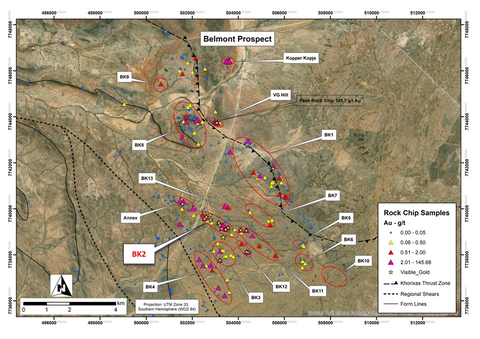Great Quest Drills 18m of 1.72 g/t Au including 8m at 3.72g/t Au at its BK2 Target, Namibia
This press release features multimedia. View the full release here: https://www.businesswire.com/news/home/20240930248753/en/

Figure 1: Rock chip samples from
Highlights
- Hole BKDD003 intersected 18m of 1.72 g/t Au from 74m including 8m of 3.72 g/t Au
- BKDD003 also intersected multiple points of visible gold within the 18m zone of mineralization
- BKDD003 confirms the down-dip extension of the previously intersected 6m of 6.85 g/t Au from 20m at the BK2 target
About the
BK2 Target
The BK2 target area is predominantly defined by a NW/SE trend of high-grade surface float samples. Approximately 95% of the target area is covered by a 1-5m thick calcrete cover, with small patches of sulphide-rich quartz zones outcropping. The BK2 rock chip trend can be traced for approximately 1.5km, however, when combined with the down strike Annex and BK11 targets this trend increases to approximately 5km (Fig. 2). Limited outcrop suggests that the mineralization is associated with structurally controlled quartz veins hosted in altered muscovite-chlorite schists and arkosic sandstones (Fig. 3). Alteration is typically associated with mineralized zones and includes: silicification, chloritization and iron-carbonate replacement of host rock.
A total of 570m of diamond drilling was completed as part of a maiden scout drilling campaign by the Company (Table 2). Drilling was conducted at the VG Hill target (BKDD001 & BKDD002) and the BK2 target (BKDD003 & BKDD004). The best hole, BKDD003, intersected multiple quartz and sulphide-rich zones between 74m and 92m downhole, including a 1m zone of massive sulphide comprising pyrite and pyrrhotite (Fig. 4B & C). Assay results for this hole reported 18m of 1.72 g/t Au from 74m including 8m of 3.72 g/t Au. Drilling also intersected 2 points of visible gold at 84.4m and 86.1m with individual meters only assaying 0.5 g/t Au and 0.08 g/t Au respectively (Fig. 4A). The nuggety nature of mineralization at the BK2 target has been observed in surface samples and all assays were therefore analyzed using the screen fire assay method. It is, however, expected that due to the nuggety nature of this system, some gold might be missed even while using the screen fire assay method.
Down-Dip Extension
Hole BKDD003 was intended to prove the down-dip extension of the previously intersected zone of 6m of 6.85 g/t Au at 20m, recorded in hole BKP0036. The mineralization intersected by hole BKDD003 proves the down-dip extension of mineralization to a vertical depth of approximately 80m (Fig. 5). The interpreted mineralized zone dips steeply (75ᵒ) to the SW and future drilling will take this into consideration. The interpreted mineralized zone can also be traced to surface where two visible gold samples as well as one grab sample assaying 15.55 g/t Au were recorded in quartz sulphide float. The newly discovered mineralized zone remains open in all directions.
Future Work
Recent drilling has proven the in-situ continuity of high-grade gold mineralization within the
Table 1: Table displaying intercepts above 0.5 g/t Au.
|
Hole ID |
From |
To |
Interval (m) |
Au (g/t) |
|
BKDD001 |
103 |
104 |
1 |
0.52 |
|
BKDD003 |
74 |
92 |
18 |
1.72 |
|
|
including |
8 |
3.72 |
|
Table 2: Table showing the coordinates of holes drilled by the Company.
|
Hole ID |
X |
Y |
Z |
Azimuth |
Dip |
Depth (m) |
|
BKDD001 |
503084.9 |
7743768 |
1008 |
185 |
60 |
150 |
|
BKDD002 |
503036.8 |
7743666 |
1006 |
15 |
50 |
130 |
|
BKDD003 |
503162.2 |
7739441 |
1009 |
170 |
60 |
140 |
|
BKDD004 |
503407.4 |
7739309 |
1012 |
160 |
60 |
150 |
“We are excited about the new developments in the Belmont Project”, commented Dr.
Quality Assurance & Quality Control (QA/QC)
All sample assay results have been monitored through the Company's quality assurance / quality control (QA / QC) program following E2941 − 21 Standard Practices for Extraction of Elements from Ores and Related Metallurgical Materials by 4 acid Digestion with ICPOES finish. Drill core was sent to an independent laboratory, African Laboratory Specialists Namibia (“ALS”), for analysis. ALS is an independent laboratory, located in Kombat,
Qualified Person
The scientific and technical information in this release has been reviewed and approved by Dr.
Change of Transfer Agent
Great Quest also announces the appointment of
About Great Quest
ON BEHALF OF THE BOARD OF DIRECTORS OF GREAT QUEST GOLD LTD.
CEO and Executive Chairman
Disclaimer for Forward-Looking Information
This news release may contain forward-looking statements. Forward-looking statements include, without limitation, the mineralization and prospectivity of the
Neither the
View source version on businesswire.com: https://www.businesswire.com/news/home/20240930248753/en/
For more information:
Please contact Investor Relations by email at IR@greatquest.com
Source:
